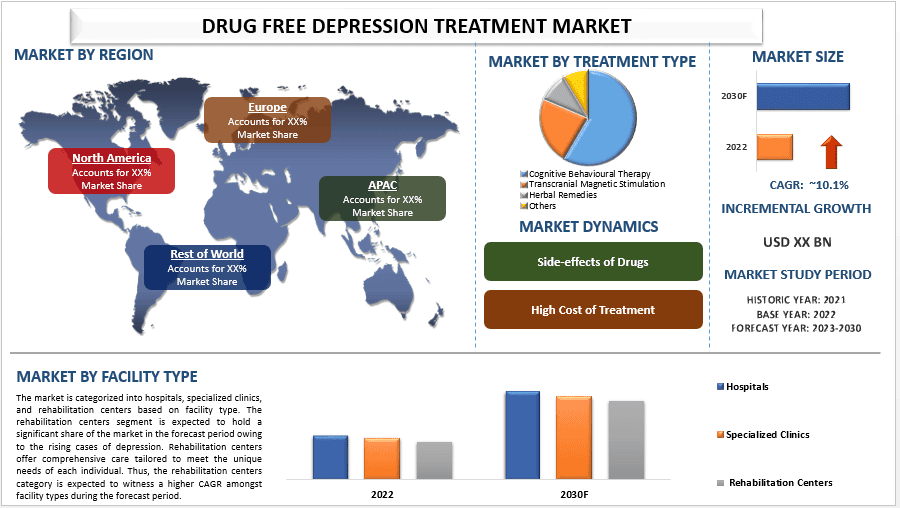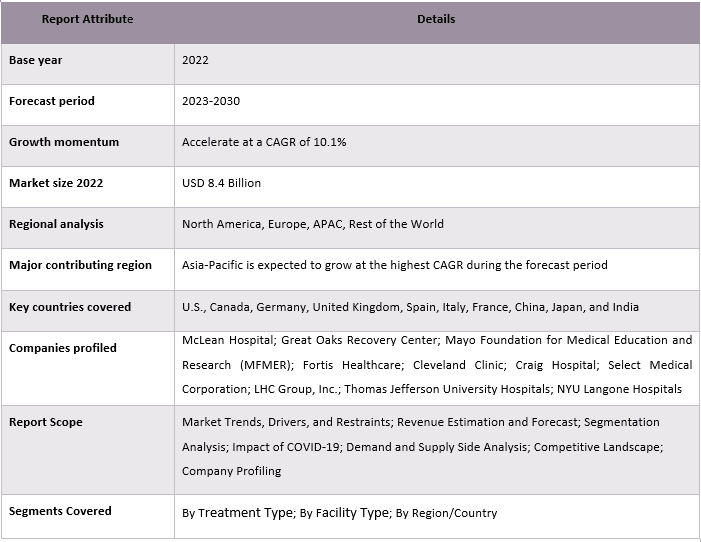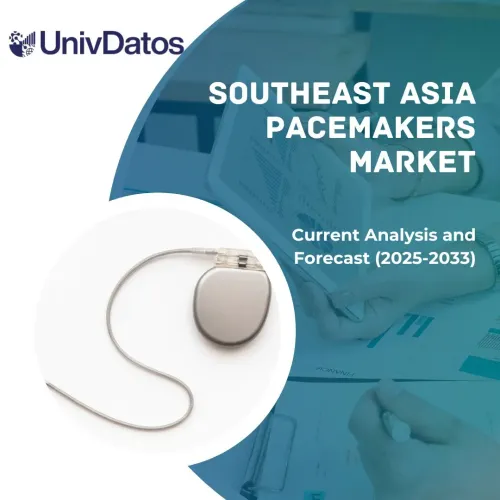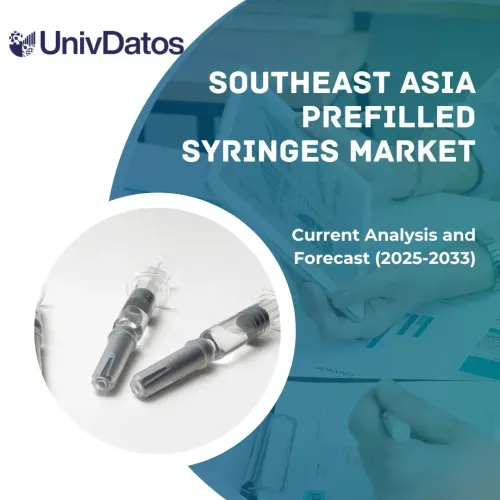- Home
- About Us
- Industry
- Services
- Reading
- Contact Us
Drug Free Depression Treatment Market: Current Analysis and Forecast (2023-2030)
Emphasis on Treatment Type (Cognitive Behavioural Therapy, Transcranial Magnetic Stimulation, Herbal Remedies, and Others); Facility Type (Hospitals, Specialized Clinics, and Rehabilitation Centers); and Region/Country

The drug free depression treatment market was valued at USD 8.4 Billion in 2022 and is expected to grow at a CAGR of 10.1% during the forecast period (2023-2030). Depression can be triggered by a combination of genetic, biological, environmental, and psychological factors, and it often coexists with other mental health conditions such as anxiety disorders or substance abuse. Drug free treatment for depression typically involves a combination of therapies, including psychotherapy, medication, lifestyle changes, and support from friends, family, or support groups. Drug free depression treatment mainly gained prominence in the market due to the rising innovations for developing drug free depression treatment. For instance, in July 2023, Flow Neuroscience, a small Swedish company treating depression with brain-stimulating headsets, claimed that their device relieved depressive symptoms in clinical trials. In addition to this, investments in psychology departments as well as government awareness programs regarding mental health have increased significantly in recent years, which are the key factors that are creating opportunities for the market.
McLean Hospital; Great Oaks Recovery Center; Mayo Foundation for Medical Education and Research (MFMER); Fortis Healthcare; Cleveland Clinic; Craig Hospital; Select Medical Corporation; LHC Group, Inc.; Thomas Jefferson University Hospitals; NYU Langone Hospitals are some of the key players in the market. Several M&As along with partnerships have been undertaken by these players to facilitate customers with hi-tech and innovative products/technologies.
Insights Presented in the Report
“Amongst treatment type, herbal remedies category to witness higher CAGR during the forecast period”
Based on the treatment type, the market is segmented into cognitive behavioural therapy, transcranial magnetic stimulation, herbal remedies, and others. The herbal remedies segment is expected to grow with a high CAGR during the forecast period because of the growing adaptation of organic medications. Herbal remedies have been used for centuries in the treatment of various health conditions, including depression. Herbal remedies are efficient in relieving people suffering from depression. Thus, the herbal remedies segment among treatment types is expected to witness a higher CAGR during the forecast period.
“Amongst facility type, hospitals held a significant share in the market in 2022”
Based on facility type, the market is categorized into hospitals, specialized clinics, and rehabilitation centers. The hospital segment is dominating the market owing to the growth in the number of hospitals globally. For instance, according to the American Hospital Association in 2023, there are in total of 6,129 hospitals in the U.S with 919,649 staffed beds and 34,011,386 hospital admissions in the year 2022. Hospitals serve as primary healthcare institutions where patients receive diagnosis, treatment, and ongoing care. They play a pivotal role in patient management by providing state-of-the-art medical facilities, specialized expertise, and a multidisciplinary approach to patient care. The hospitals offer treatment to many patients, allowing them to capitalize on economies of scale and offer more efficient and cost-effective services. Thus, hospitals held a significant share in the drug free depression treatment market in 2022.
“Amongst regions, APAC is expected to witness a higher CAGR during the forecast period”
APAC is expected to grow with a high CAGR in the global drug free depression treatment market in the forecast period. Several factors such as a surge in the introduction of a wide range of drug free depression treatments, enhanced accessibility, and diversified healthcare costs are driving the market’s growth during the forecast period. Further, the increase in incidences of depression and anxiety is also having a positive impact on the market’s growth. For instance, according to the Times of India’s report in April 2023, depression rates are increasing among young people in India with prevalence rates ranging from 31% to 57%. There have been major awareness programs regarding mental health in the region. Thus, APAC is expected to witness a higher CAGR during the forecast period.

Reasons to buy this report:
- The study includes market sizing and forecasting analysis validated by authenticated key industry experts.
- The report presents a quick review of overall industry performance at one glance.
- The report covers an in-depth analysis of prominent industry peers with a primary focus on key business financials, product portfolio, expansion strategies, and recent developments.
- Detailed examination of drivers, restraints, key trends, and opportunities prevailing in the industry.
- The study comprehensively covers the market across different segments.
- Deep dive regional level analysis of the industry.
Customization Options:
The global drug free depression treatment market can further be customized as per the requirement or any other market segment. Besides this, UMI understands that you may have your own business needs, hence feel free to connect with us to get a report that completely suits your requirements.
Table of Content
Research Methodology for the Drug Free Depression Treatment Market Analysis (2023-2030)
Analyzing the historical market, estimating the current market, and forecasting the future market of the global drug free depression treatment market were the three major steps undertaken to create and analyze the adoption of drug free depression treatment in major regions globally. Exhaustive secondary research was conducted to collect the historical market numbers and estimate the current market size. Secondly, to validate these insights, numerous findings and assumptions were considered. Moreover, exhaustive primary interviews were also conducted, with industry experts across the value chain of the global drug free depression treatment market. Post assumption and validation of market numbers through primary interviews, we employed a top-down/bottom-up approach to forecasting the complete market size. Thereafter, market breakdown and data triangulation methods were adopted to estimate and analyze the market size of segments and sub-segments of the industry pertains to. Detailed methodology is explained below:
Analysis of Historical Market Size
Step 1: In-Depth Study of Secondary Sources:
Detail secondary study was conducted to obtain the historical market size of the drug free depression treatment market through company internal sources such as annual reports & financial statements, performance presentations, press releases, etc., and external sources including journals, news & articles, government publications, competitor publications, sector reports, third-party database, and other credible publications.
Step 2: Market Segmentation:
After obtaining the historical market size of the drug free depression treatment market, we conducted a detailed secondary analysis to gather historical market insights and share for different segments & sub-segments for major regions. Major segments are included in the report as treatment type, facility type, and regions. Further country-level analyses were conducted to evaluate the overall adoption of testing models in that region.
Step 3: Factor Analysis:
After acquiring the historical market size of different segments and sub-segments, we conducted a detailed factor analysis to estimate the current market size of the drug free depression treatment market. Further, we conducted factor analysis using dependent and independent variables such as treatment type, facility type, and regions of drug free depression treatment. A thorough analysis was conducted for demand and supply-side scenarios considering top partnerships, mergers and acquisitions, business expansion, and product launches in the drug free depression treatment market sector across the globe.
Current Market Size Estimate & Forecast
Current Market Sizing: Based on actionable insights from the above 3 steps, we arrived at the current market size, key players in the global drug free depression treatment market, and market shares of the segments. All the required percentage shares split and market breakdowns were determined using the above-mentioned secondary approach and were verified through primary interviews.
Estimation & Forecasting: For market estimation and forecast, weights were assigned to different factors including drivers & trends, restraints, and opportunities available for the stakeholders. After analyzing these factors, relevant forecasting techniques i.e., the top-down/bottom-up approach were applied to arrive at the market forecast for 2030 for different segments and sub-segments across the major markets globally. The research methodology adopted to estimate the market size encompasses:
- The industry’s market size, in terms of revenue (USD) and the adoption rate of the drug free depression treatment market across the major markets domestically
- All percentage shares, splits, and breakdowns of market segments and sub-segments
- Key players in the global drug free depression treatment market in terms of products offered. Also, the growth strategies adopted by these players to compete in the fast-growing market
Market Size and Share Validation
Primary Research: In-depth interviews were conducted with the Key Opinion Leaders (KOLs) including Top Level Executives (CXO/VPs, Sales Head, Marketing Head, Operational Head, Regional Head, Country Head, etc.) across major regions. Primary research findings were then summarized, and statistical analysis was performed to prove the stated hypothesis. Inputs from primary research were consolidated with secondary findings, hence turning information into actionable insights.
Split of Primary Participants in Different Regions

Market Engineering
The data triangulation technique was employed to complete the overall market estimation and to arrive at precise statistical numbers for each segment and sub-segment of the global drug free depression treatment market. Data was split into several segments & sub-segments post studying various parameters and trends in the areas of treatment type, facility type, and regions in the global drug free depression treatment market.
The main objective of the Global Proteasome Inhibitor Market Study
The current & future market trends of the global drug free depression treatment market were pinpointed in the study. Investors can gain strategic insights to base their discretion for investments on the qualitative and quantitative analysis performed in the study. Current and future market trends determined the overall attractiveness of the market at a regional level, providing a platform for the industrial participant to exploit the untapped market to benefit from a first-mover advantage. Other quantitative goals of the studies include:
- Analyze the current and forecast market size of the drug free depression treatment market in terms of value (USD). Also, analyze the current and forecast market size of different segments and sub-segments.
- Segments in the study include areas of treatment type, facility type, and regions.
- Define and analyze the regulatory framework for the drug free depression treatment industry.
- Analyze the value chain involved with the presence of various intermediaries, along with analyzing customer and competitor behaviors of the industry.
- Analyze the current and forecast market size of the drug free depression treatment market for the major region.
- Major countries of regions studied in the report include Asia Pacific, Europe, North America, and the Rest of the World.
- Company profiles of the drug free depression treatment market and the growth strategies adopted by the market players to sustain in the fast-growing market.
- Deep dive regional level analysis of the industry.
Frequently Asked Questions FAQs
Q1: What is the current market size and growth potential of the drug free depression treatment market?
Q2: What are the driving factors for the growth of the drug free depression treatment market?
Q3: Which segment has the largest share of the drug free depression treatment market by treatment type?
Q4: What are the emerging technologies and trends in the drug free depression treatment market?
Q5: Which region will dominate the drug free depression treatment market?
Q6: Who are the key players operating in the drug free depression treatment market?
Related Reports
Customers who bought this item also bought










